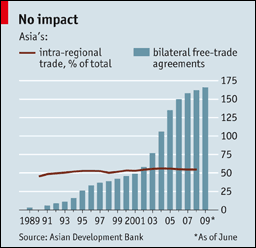Asian trade : The noodle bowl

The Economist | Sep 3rd 2009
Asian trade : The noodle bowl
Why trade agreements are all the rage in Asia
THESE are worrying times for world trade. Despite a recent levelling out after the first quarter’s collapse, the World Trade Organisation reckons global trade volumes will be around 10% lower this year than in 2008. Trade ministers convened in New Delhi this week to talk about resurrecting the Doha trade talks—but those talks remain moribund. Yet amid the general gloom, activity on one sort of trade—bilateral free-trade agreements (FTAs)—continues at a feverish pace in Asia. This month, another deal was signed, this time between India and South Korea.
The agreement is the first between two of Asia’s four biggest economies (India, China, Japan and South Korea). But the stream of FTAs, typically between one large economy and a smaller partner, has become a flood in the past decade. From just six in 1991, their number had increased to 42 by 1999. But almost three times as many have been signed since, bringing the number of such agreements in Asia to 166 by June this year, according to the Asian Development Bank (ADB).
Still more—62 at last count—are at various stages of negotiation, including one between Japan and India. China and Taiwan are in talks about a deal, which shows just how deeply FTA fever has taken hold of Asia (trade deals are even used as a way to bridge the gulf between the two Chinas). And apart from bilateral agreements, several countries, including China and Japan, now have signed trade deals with the Association of South-East Asian Nations (ASEAN), a regional body.
Asian countries’ enthusiasm for bilateral agreements is palpable, and they have reason to want to bolster intra-Asian trade. The growth of global supply chains means that parts made in one Asian country from raw materials imported from another are re-exported to a third for final assembly. These countries hope that more bilateral agreements will enable more specialisation. India, for example, hopes that its new FTA will allow it to become a hub for Korean electronics companies seeking to exploit lower labour costs to make goods destined for markets in the Middle East.
Added to all this is the fact that Asia’s big economies are set to provide the world with most of its growth this year, and emerging Asia will continue to be the world’s fastest-growing region for several years. Strategic rivalries complete the list of incentives. Many think that India has jumped into the fray because China has been signing one pact after another.
But economists caution that the proliferation of FTAs is unlikely to do wonders for the region’s trade. Aaditya Mattoo, of the World Bank, points out that because trade barriers in Asia are already relatively low, the benefit of a small further reduction in barriers in one market is tiny.
Bilateral deals come laden with complicated rules about where products originate—rules which impose substantial costs of labelling and certification on firms. The more overlapping deals there are, the more complex the rules and the higher the costs. Those who follow Asia’s FTA mania refer to this as the “noodle bowl”. No wonder few firms actually want to use FTAs. An ADB survey of exporters in Japan, South Korea, Singapore and Thailand in 2007-08 found that only 22% took advantage of them. Certainly, the huge rise in trade deals seems to have done nothing to boost the share of the continent’s trade that is intra-Asian (see chart).
Countries may worry that a multilateral deal would erode the preferential terms they got through bilateral ones. If so, the flurry of bilateral deals may have come at the expense of a world trade agreement. Gary Hufbauer of the Peterson Institute of International Economics in Washington, DC, thinks that China and India have decided they would “rather pursue bilateral FTAs than make the necessary concessions to push Doha across the finish line.”
Some would dispute that. India, widely blamed for contributing to the collapse of the Doha talks in July 2008, is now holding a summit of trade ministers which aims to bridge the gap between world leaders’ repeated promises to complete the round by 2010 and the reality that, as one WTO insider puts it, “nothing is happening on the ground”. Indian politics should allow greater negotiating flexibility, if talks restart, thanks to a stronger government and an opposition in disarray. But a deal will require America to build up domestic support for more open trade. Until that happens, Asian countries may content themselves with a fuller noodle bowl.





